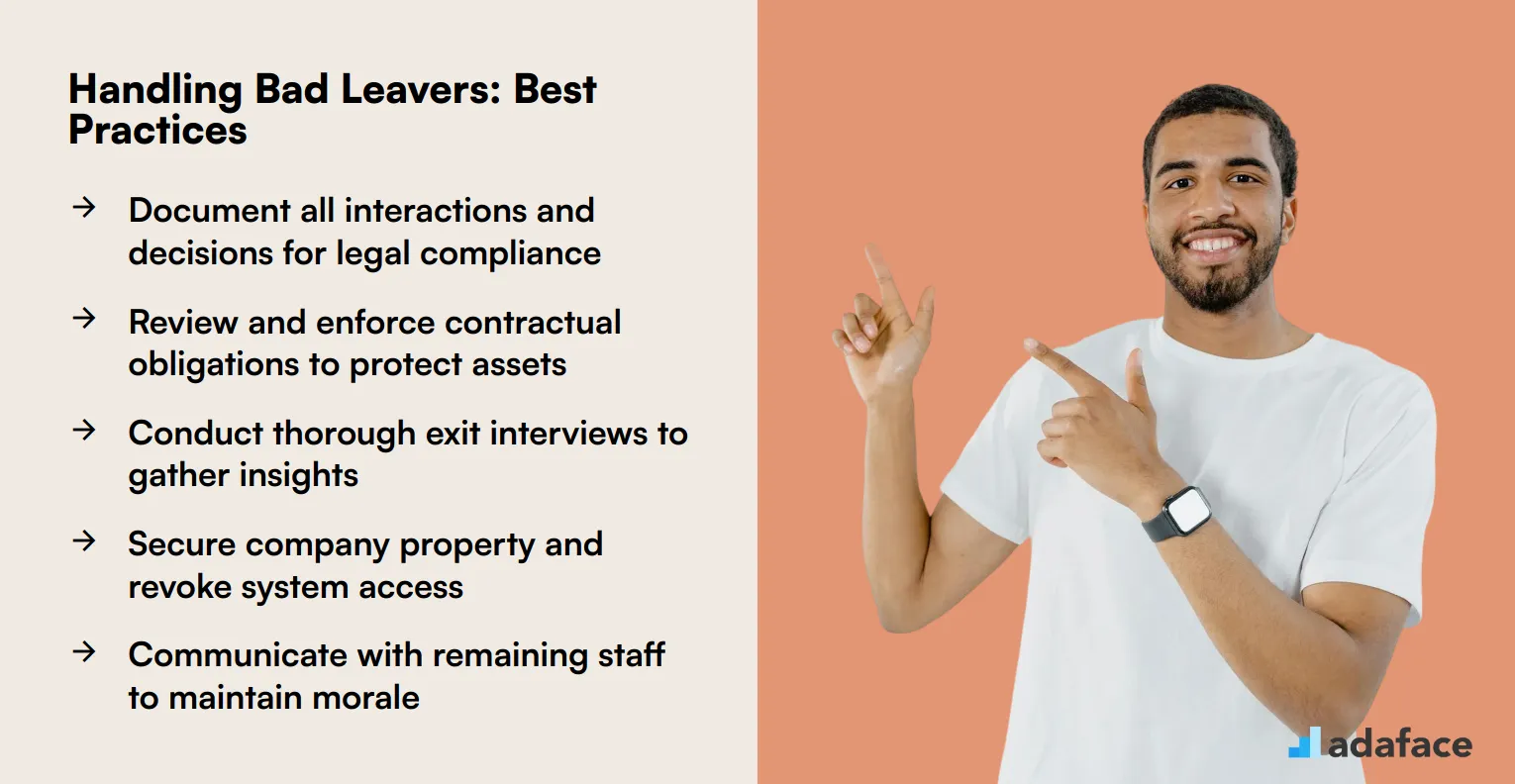Dealing with bad leavers is a challenge every recruiter faces. It's important to understand what defines a bad leaver and how their actions can impact your company.
This guide will equip you with the knowledge to identify potential bad leavers, mitigate risks, and implement best practices for a smoother offboarding process. Learn how to improve your candidate experience and protect your company's reputation.
Table of contents
What is a Bad Leaver?
A "bad leaver" is a term used to describe an employee who departs from a company under negative circumstances. This can include instances where the employee is terminated for misconduct or breaches their employment contract. Understanding the concept of a bad leaver is important for recruiters and hiring managers, as it can impact future hiring decisions. Companies often have specific clauses in employment contracts to address bad leavers, ensuring they protect their interests. Recognizing the traits of a potential bad leaver during the recruitment process can save a company from future complications. By being aware of red flags, such as frequent job changes or past disputes, recruiters can make informed decisions when assessing candidates.
Common Reasons for Bad Leavers
Bad leavers often result from various workplace issues and personal circumstances. Understanding these common reasons can help organizations address underlying problems and improve retention rates.
Poor job fit is a frequent cause of employees becoming bad leavers. When an employee's skills, interests, or values don't align with their role or the company culture, it can lead to dissatisfaction and eventual departure.
Conflict with management or colleagues can push employees towards becoming bad leavers. Unresolved disputes, lack of support, or toxic work environments can drive even talented individuals to leave on negative terms.
Lack of career growth opportunities is another significant factor. Employees who feel stagnant in their roles or see no clear path for advancement may seek opportunities elsewhere, sometimes abruptly.
Work-life balance issues can transform good employees into bad leavers. Excessive workload, unrealistic expectations, or inflexible schedules can cause burnout and prompt sudden departures.
Finally, personal circumstances such as health issues, family responsibilities, or relocation needs can lead to bad leaver situations. While these reasons may be beyond an employer's control, how they're handled can impact the leaving process and the employee's lasting impression of the company.
Impact on Company Culture and Morale
Impact on Company Culture and Morale
A bad leaver can act like a tiny tornado, swirling through your company's culture and leaving a trail of disruption. Their negative attitude or actions can quickly spread, affecting team dynamics and overall morale, much like a virus spreads.
Imagine a domino effect: one disgruntled employee can influence others, leading to decreased productivity and increased tension. This can create a toxic environment where employees feel unappreciated and unmotivated, which is the opposite of what you want.
Furthermore, a bad leaver's actions can damage trust within the team and with leadership. Other employees might start questioning management's decisions or feeling insecure about their own positions, leading to a breakdown in team dynamics.
Ultimately, addressing bad leavers promptly and effectively is important to protect your company's culture and maintain a positive work environment. Ignoring the situation can lead to long-term damage, making it harder to attract and retain top talent, and you might need to rethink your retention strategy.
Legal Implications of Bad Leavers
Bad leavers can face significant legal consequences depending on the terms of their employment contract and company policies. These may include financial penalties, legal action for breach of contract, or restrictions on future employment opportunities.
Employers often include bad leaver clauses in contracts to protect their interests and deter employees from leaving in a manner that harms the company. Such clauses might require employees to forfeit certain benefits, stock options, or bonuses if they leave under specific circumstances.
In some cases, bad leavers may be subject to non-compete or non-disclosure agreements that extend beyond their employment. Violating these agreements can result in lawsuits and potential damages awarded to the former employer.
Employers should be cautious when enforcing bad leaver provisions to avoid potential claims of unfair treatment or discrimination. It's crucial to apply these clauses consistently and in accordance with relevant employment laws.
Legal implications can also extend to the bad leaver's future job prospects. Negative references or information shared during background checks may impact their ability to secure new employment.
Both employers and employees should seek legal advice to understand their rights and obligations regarding bad leaver situations. This can help prevent misunderstandings and ensure compliance with applicable laws and regulations.
Preventing Bad Leaver Situations
Preventing bad leaver situations starts with clear communication and robust policies. Establish comprehensive employment contracts that outline expectations, responsibilities, and consequences for early departure or misconduct.
Implement regular performance reviews and feedback sessions to address issues proactively. This allows for early intervention and potential course correction before situations escalate to a bad leaver scenario.
Foster a positive work environment that encourages open dialogue and employee engagement. When employees feel valued and heard, they're less likely to leave abruptly or on negative terms.
Offer competitive compensation packages and growth opportunities to retain top talent. Regularly assess market rates and provide avenues for professional development to keep employees motivated and committed.
Develop a structured offboarding process that includes exit interviews and knowledge transfer protocols. This helps maintain continuity and reduces the impact of departures on team dynamics and productivity.
Consider implementing non-compete clauses or garden leave provisions in contracts for key positions. These measures can protect company interests and mitigate potential risks associated with employee departures.
Handling Bad Leavers: Best Practices
Dealing with bad leavers requires a strategic approach to minimize disruption and protect company interests. Here are some best practices for handling employees who exit on negative terms:
Communicate clearly and document everything. Ensure all interactions and decisions regarding the bad leaver are recorded and shared with relevant parties to maintain transparency and legal compliance.
Review and enforce contractual obligations. Check employment agreements for clauses related to confidentiality, non-compete, and intellectual property to protect your organization's assets.
Conduct a thorough exit interview. Use this opportunity to gather insights, address concerns, and potentially mitigate some of the negative feelings the employee may have.
Secure company property and data. Immediately revoke access to systems, retrieve physical assets, and ensure all sensitive information is protected.
Prepare the team and maintain morale. Communicate appropriately with remaining staff to address any concerns and maintain a positive work environment.
Learn from the experience. Analyze the situation to identify any underlying issues that may have contributed to the bad leaver scenario and implement improvements in your processes.

Conclusion
Bad leavers can significantly impact a company's operations, culture, and reputation. By understanding the concept and implementing preventive measures, organizations can minimize the occurrence of bad leaver situations.
Proactive management and clear communication are key to addressing potential issues before they escalate. Handling bad leavers professionally and legally not only protects the company but also maintains a positive work environment for remaining employees.
Remember, every employee departure is an opportunity to learn and improve organizational processes. By treating all leavers with respect and following best practices, companies can turn potentially negative situations into positive learning experiences.
Bad Leaver FAQs
Signs can include decreased productivity, negative attitude shifts, increased absenteeism, and disregard for company policies. Keep an eye out for these behavioral changes.
Ensure clear employment contracts and offboarding procedures are in place. Document all performance issues and disciplinary actions, and seek legal counsel when necessary.
Focus on person-organization fit during hiring, provide regular feedback and development opportunities, and foster a positive work environment. These can reduce the likelihood of employees leaving on bad terms.
Maintain professionalism and respect throughout the process. Document all communication, conduct an exit interview, and ensure a smooth handover of responsibilities.
A bad leaver can negatively impact morale, create distrust among employees, and damage the company's reputation. Addressing the situation promptly and effectively is crucial.
Using talent assessment tools during the hiring process can help identify candidates who align with your company's values and culture. This reduces the risk of hiring individuals who may become bad leavers.

40 min skill tests.
No trick questions.
Accurate shortlisting.
We make it easy for you to find the best candidates in your pipeline with a 40 min skills test.
Try for freeRelated terms



